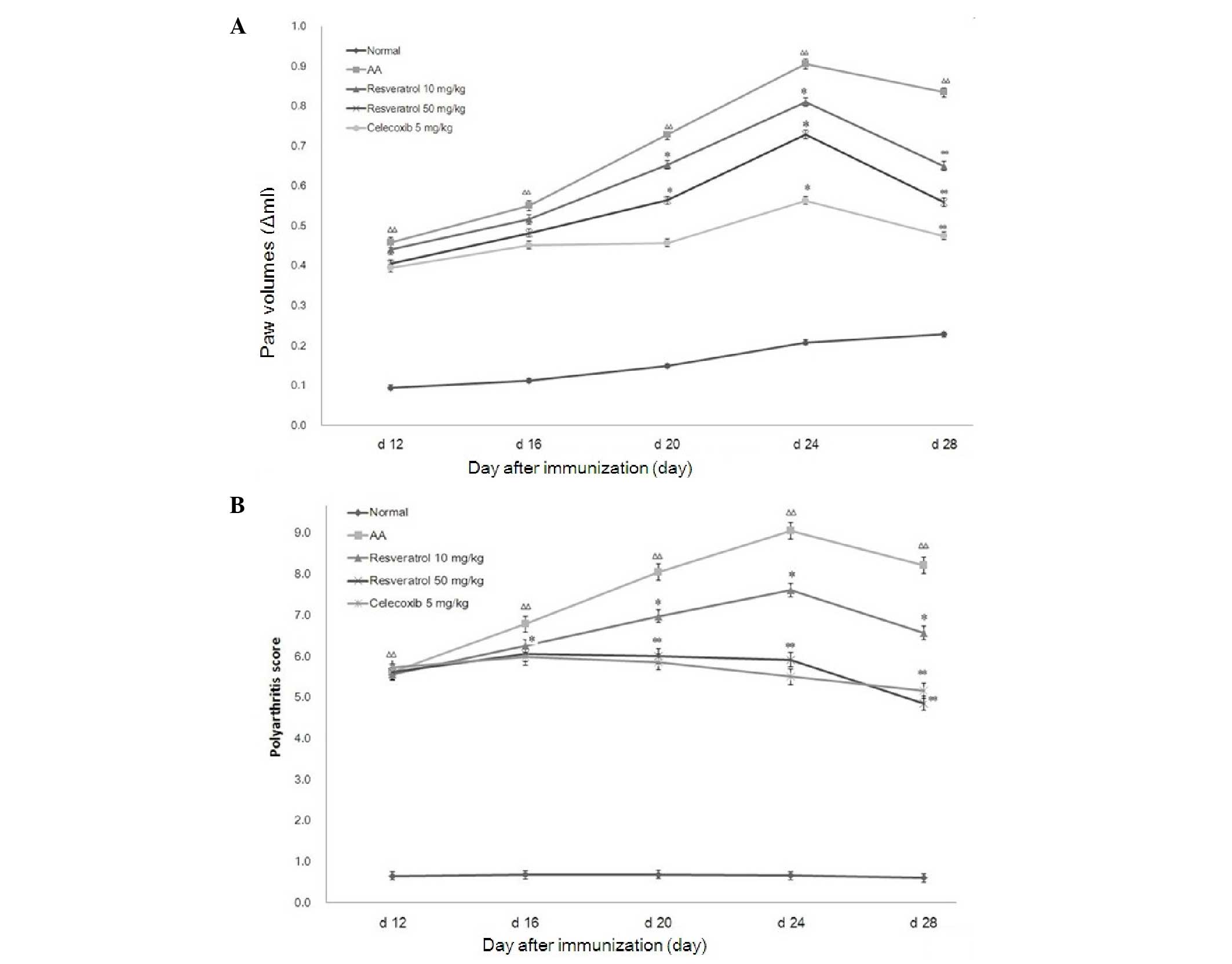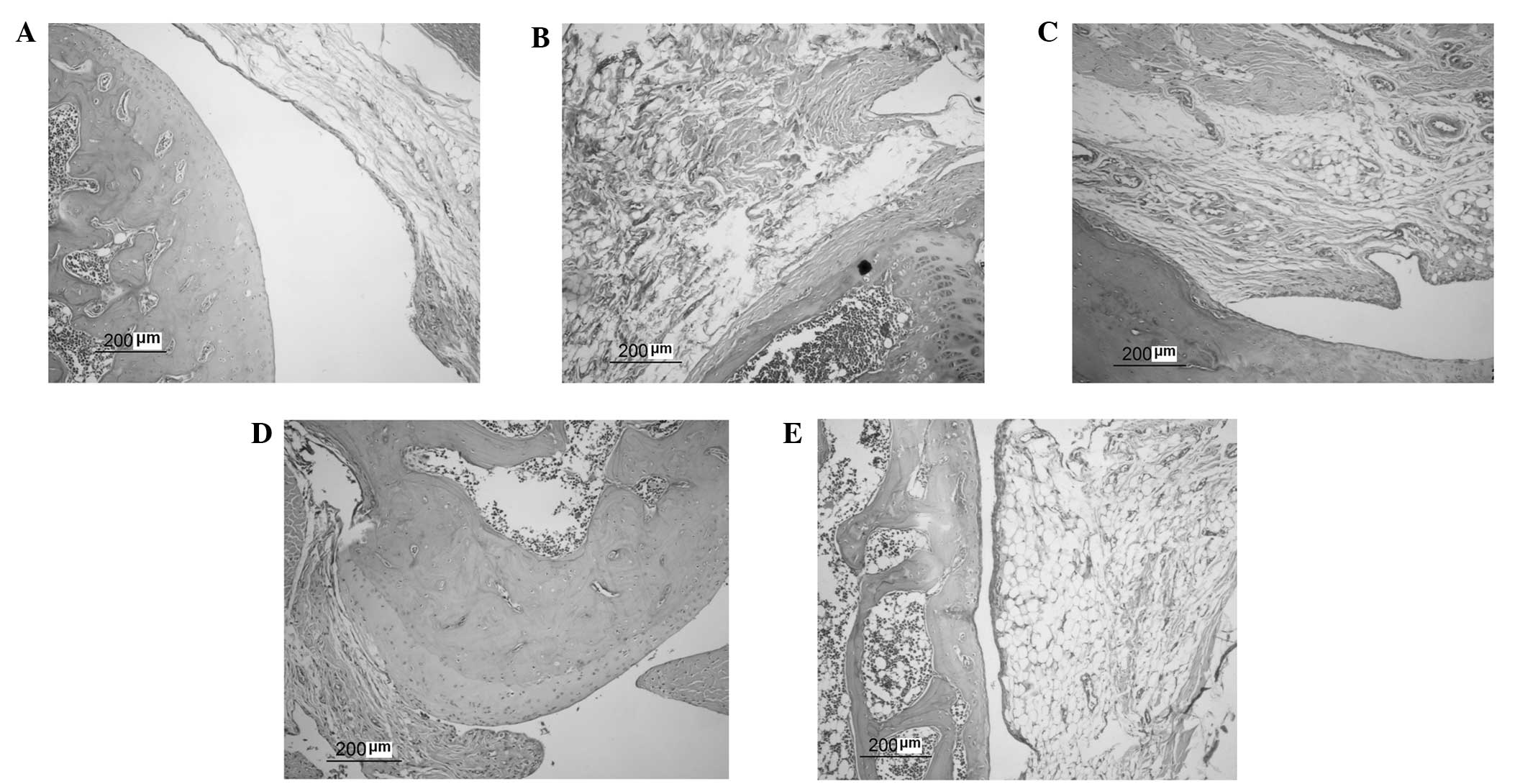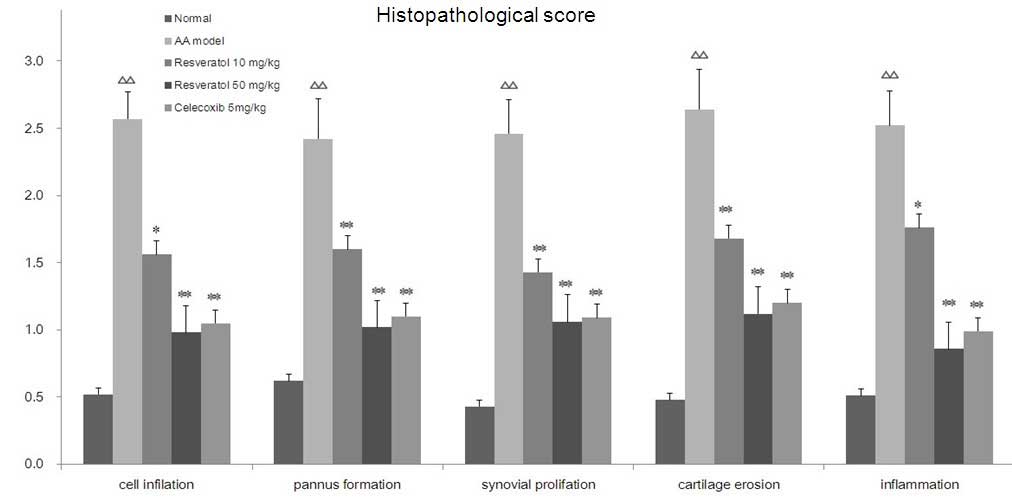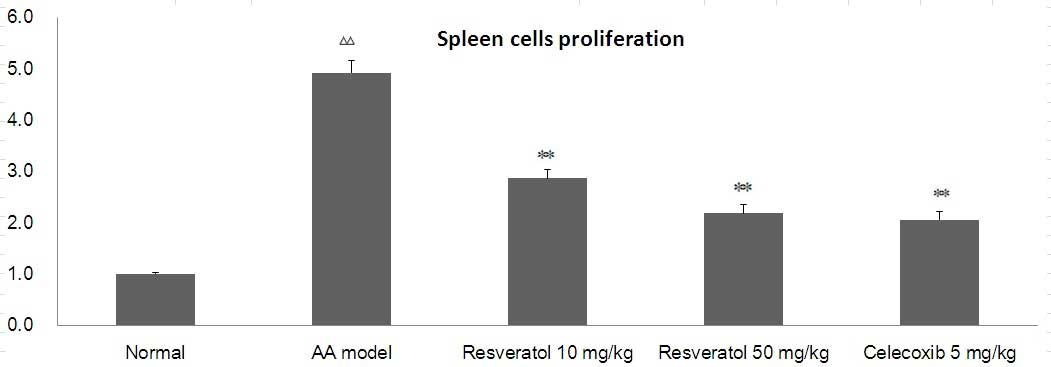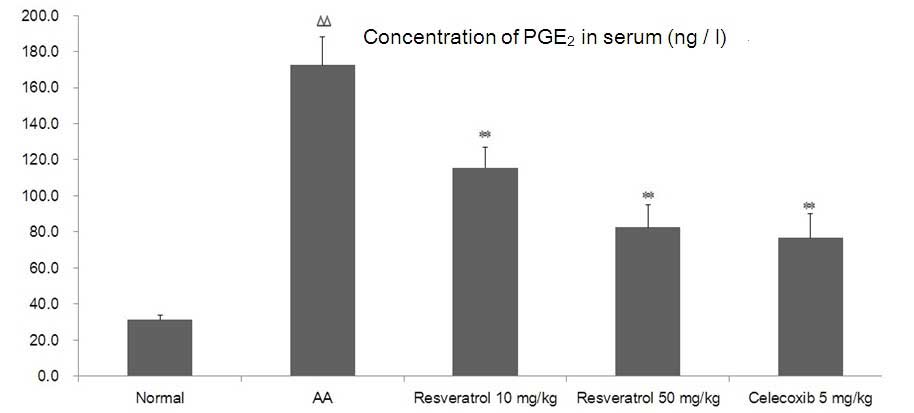Anti‑inflammatory effect of resveratrol on adjuvant arthritis rats with abnormal immunological function via the reduction of cyclooxygenase‑2 and prostaglandin E2
- Authors:
- Published online on: March 24, 2014 https://doi.org/10.3892/mmr.2014.2070
- Pages: 2592-2598
Abstract
Introduction
Rheumatoid arthritis (RA) is a chronic inflammatory disease with an unknown etiology leading to cartilage and bone erosion and has a severe impact on human health and quality of life (1,2). At present, the pathological characteristics of RA mainly include joint inflammation of the synovial tissue and excessive hyperplasia (3). The variation in hematology and joint histopathology of adjuvant arthritis (AA) rats, which is a commonly used animal model, is similar to human RA (4). Resveratrol, a natural plant flavone, which is abundantly present in grapes, fruit, red wine and other food products and medicinal plants, possesses pharmacological effects, including immune-regulatory, anti-inflammatory, antioxidant and antitumor activity (5–7). Resveratrol has been demonstrated to inhibit the enzymatic activity of cyclooxygenase (COX)-1 and COX-2, which are important in the pathogenesis of RA (8,9). COX is a key rate-limiting enzyme of prostaglandin (PG) production in organisms. It has previously been reported that resveratrol is able to inhibit several experimental autoimmune diseases (10,11). Based on previous studies concerning resveratrol and its anti-arthritic activity the anti-inflammatory mechanism of resveratrol on the animal model of AA rats, which involves COX-2 and PGE2 associated with RA is remains inadequate (12,13). However, the detailed mechanisms underlying the protective effects of resveratrol on arthritis remain to be fully elucidated. In addition, oral administration of resveratrol (10 or 50 mg/kg body weight) over a period of two weeks reversed arthritis dysfunction in AA rats (12,14). The aim of the present study was to detect the anti-inflammatory effects of resveratrol in an AA rat model and to determine the underlying mechanism of action.
Materials and methods
Animals
Male Sprague-Dawley (SD) rats (weight, 200±20 g; age, 8–10 weeks; certificate no., 2013–0002) were obtained from the Laboratory Animal Center of Anhui Medical University (Hefei, China). All experimental procedures were approved for the use of animals in research by the Ethics Review Committee for Animal Experimentation (Anhui Medical University). The animals were housed in standard laboratory conditions and fed ad libitum with a controlled ambient temperature of 22±2°C and a humidity of 50–60%. A 12 h light/dark cycle was maintained at all times. The rats were housed with five animals per cage, acclimated to the housing conditions and handled for 1 week prior to experiments.
Reagents
Resveratrol (purity, 99%) was purchased from Sigma (St. Louis, MO, USA) and was dissolved in dimethylsulfoxide (DMSO). Celecoxib, which was also dissolved in DMSO, was purchased from Shanghai Pharmaceutical Co., Ltd. (Shanghai, China). Celecoxib is widely used in the treatment of RA as a selective COX-2 inhibitor and as positive drugs (15). Dulbecco’s modified Eagle’s medium (DMEM) was purchased from HyClone Laboratories, Inc. (Logan, UT, USA). All other reagents were of analytical purity. ELISA kits for PGE2 were purchased from Research & Development Systems, Inc. (Minneapolis, MN, USA). A stock solution was prepared in DMSO and the final concentration of DMSO with diluted phosphate-buffered saline (PBS) was 0.05% (w/v). Rabbit polyclonal anti-COX-2 antiserum was obtained from Santa Cruz Biotechnology, Inc. (Santa Cruz, CA, USA) and concanavalin A (con A) was purchased from Sigma.
Methods
Induction of AA
AA model rats were induced as previously described (16,17). Briefly, complete Freund’s adjuvant (CFA) was purchased from Sigma and suspended in heat-killed bacillus Calmette-Guerin (Shanghai Biochemical Institute, Shanghai, China) in liquid paraffin at 10 mg/ml. Arthritis was induced in SD rats by intradermal injection of 0.1 ml CFA emulsion into the right hind metatarsal footpad. The normal control rats were intradermally injected with 0.1 ml liquid paraffin into the right hind feet pads.
Treatment of AA
The rats were randomly divided into the following five groups (n=10 per group): The normal group, AA model group, AA rats which were administered resveratrol via continuous intragastric gavage (10 or 50 mg/kg, daily) and rats treated with celecoxib (5 mg/kg, every day) between day 12 and day 28 after immunization. The normal and AA model rat groups were subcutaneously administered the same volume of (0.05%, w/v) the vehicle (DMSO) for the same time period.
Assessment of arthritis
Clinical assessments were performed by two independent observers who had no knowledge of the treatment protocol. AA severity was evaluated by the previously described scoring system (18,19). The clinical parameters of non-injected swelling (left hind paw of rats) and the polyarthritis index of the AA rats were evaluated every four days between day 12 and day 28 after immunization. The left hind paw volume (ankle joint) was assessed using a water replacement plethysmometer (Shandong Academy of Medical Science, Jinan, China), the degree of swelling (Δml)=after inflammatory volume − former non-inflammatory volume. The polyarthritic scale in each paw was graded on a 0–4 scale as follows: 0, normal; 1, paws in one joint with redness and/or swelling; 2, paws in less than one joint with mild redness and/or swelling; 3, all paws with severe redness and/or swelling; and 4, paws with deformity and/or ankylosis. The cumulative score for all three non-injected paws of each rat was used as the polyarthritis index with a maximum value of 12.
Histological examination with hematoxylin and eosin (H&E) staining
Animals were anesthetized by inhalation of 2.5–4% isoflurane (Shanghai Mindray, Shanghai, China) on the day 28, and sacrificed immediately by exsanguination. The secondary hind paws were removed above the ankle joints and were fixed in 4% formaldehyde at 4°C overnight, and then decalcified in ethylenediaminetetraacetic acid buffer for 4 weeks prior to dehydration and paraffin embedding. The serial sections (3 μm) were stained with H&E to microscopically examine (Olympus Corporation, Tokyo, Japan) cell infiltration, pannus formation, synovial hyperplasia, cartilage damage and bone erosion. The pathology of the joint was scored as previously described (20) using the following scoring system: Cellular infiltration, synovial proliferation, cartilage erosion and pannus formation, graded between 0 (no infiltration/normal synovium/no changes/no abnormalities) and 4 (extensive infiltrates invading the joint capsule with maximal cellular influx/severe synovial hyperplasia and effacement of joint space and adjacent cartilage and bone/extensive deep cartilage degradation/extensive pannus formation, infiltration, flat overgrowth of the joint surface). A mean score of the paws was calculated. Evaluation of the joint pathology of the tissue specimen was repeated five times by two independent observers.
3-(4,5-dimethylthiazol-2-yl)-2,5-diphenyltetrazolium bromide (MTT) assay for lymphocyte proliferation
Lymphocyte proliferation was determined using an MTT (Sigma) assay (21). The rats were anaesthetized and sacrificed on day 28 in each group. The spleens were immediately removed under sterile conditions and gently crushed with a syringe in DMEM. Erythrocytes were filtered on a 100-mesh sieve and then washed and resuspended in DMEM. The cell suspension (100 μl) was incubated in 96-well culture plates (Corning Inc., Corning, NY, USA) with 5×106 cells/ml and six wells per sample. DMEM (100 μl) containing 10% fetal bovine serum was added to three wells (controls) and cell culture medium in the other three wells was treated with Con A (at a final concentration of 5 μg/ml). Spleen lymphocytes were incubated at 37°C in a 5% CO2 air atmosphere. Following culture for three days, 100 μl supernatant was discarded and 20 μl MTT (final concentration of 5 mg/ml) was added to each well and oscillated for 1 min on an oscillator, and incubated for 4 h. Following incubation, the cultures were centrifuged (760 × g; 10 min). Then, 150 μl DMSO (Sigma) was added to each well. The absorbance (A) was measured on a Microplate Reader Model 550 (Bio-Rad, Hercules, CA, USA) at 570 nm. The results were described as an average of A and the experiments were repeated in triplicate.
Protein expression of COX-2 detected by western blotting in synovial tissues
COX-2 protein expression was analyzed by western blotting. The rats were sacrificed on day 28 in each group. The synovial tissues of the left ankle joints were removed, weighed and grinded. The lysates were sonicated for 1 min on ice and centrifuged at 7,500 × g for 10 min to sediment the particulate material. The protein concentration of the supernatant was measured using a bicinchoninic acid assay kit (Agilent Technologies, Inc., Santa Clara, CA, USA). The protein (50 μg) was separated by 10% sodium dodecyl sulfate-polyacrylamide gel electrophoresis. The resolved proteins were transferred onto a nitrocellulose membrane (Bio-Rad) and then incubated with primary antibodies (rabbit polyclonal anti-COX-2 antiserum 1:2,000 dilution and β-actin 1:5,000 dilution) for 1 h at room temperature and then at 4°C overnight. The membrane was washed three times using Tris-buffered saline with Tween-20 and secondary antibody to IgG (Santa Cruz Biotechnology, Inc.) conjugated to horseradish peroxidase for 2 h at room temperature. The blots were probed with the enhanced chemiluminescence western blotting substrate (Pierce Biotechnology, Inc., Rockford, IL, USA). The protein expression levels were normalized to β-actin.
PGE2 levels in the serum determined by ELISA assays
On day 28, the rats were sacrificed and the serum from peripheral blood was collected and stored at −80°C prior to the assay. Concentrations of PGE2 in the serum were measured using ELISA kits according to the manufacturer’s instructions. Each serum sample was assessed in triplicate.
Statistical analysis
The results are expressed as the mean ± standard deviation, where n indicates the number of rats. Analysis of variance was used in the SPSS version 17.0 professional software (SPSS, Inc., Chicago, IL, USA) to determine significant differences between the groups. The histological scores were analyzed using a non-parametric Mann-Whitney U test. P≤0.05 was considered to indicate a statistically significant difference.
Results
Effects of resveratrol on the secondary inflammatory reaction in AA rats
SD rats in the AA groups developed typical clinical symptoms of severe arthritis (joint redness and swelling of the feet) and progressed rapidly. Compared with the normal rats, the onset of secondary arthritis (the left hind paw) significantly increased in AA rats on day 12 after immunization. Compared with the normal group, the weight of the rats in the model group markedly decreased and the left hind paw was markedly swollen. Resveratrol (10 or 50 mg/kg) was able to relieve paw swelling (P<0.01) and polyarthritis from day 24. Similar results were observed with celecoxib treatment (5 mg/kg; Fig. 1).
Effects of resveratrol on the histopathology of AA rats
On day 28 after immunization, histological features of the pathological microscopic findings were observed (Fig. 2). Joint structure sections were stained with H&E. In normal rats, the joint structures were clear, synoviocytes were monolayer and inflammatory cells had not infiltrated the articular cartilage. In AA model rats, the joint structure showed signs of severe arthritis, including synovial tissue hyperplasia, inflammatory cell infiltration in the synovial lining layer, novel blood vessel formation, and articular cartilage erosion and degradation. Resveratrol (10 or 50 mg/kg) was able to inhibit synovial hyperplasia and pannus formation, reduce inflammatory cell infiltration and alleviate the destruction of articular cartilage. Celecoxib (5 mg/kg) had similar effects to resveratrol on the histopathology of AA rats. Histopathological scores for the presence of inflammatory cell infiltration, pannus formation, synovial proliferation, cartilage erosion and synovial inflammation of the ankle joints in AA rats, which were treated with resveratrol are shown in Fig. 3. Compared with the normal group, the histopathological scores in the AA rats significantly increased (P<0.01). Treatment with resveratrol significantly decreased histopathological scores compared with the AA rats (P<0.05, P<0.01). The celecoxib-treated (5 mg/kg) group exhibited similar results to the group treated with resveratrol.
Effects of resveratrol on lymphocyte proliferation in AA rats
As shown in Fig. 4, compared with the normal group, con A-induced lymphocyte proliferation in the model group increased, while in the resveratrol group (10 or 50 mg/kg) con A-induced lymphocyte proliferation was significantly inhibited. Celecoxib (5 mg/kg) also significantly decreased T-cell proliferation (P<0.01).
Effect of resveratrol on the protein expression of COX-2 in the synovial tissues of AA rats
To investigate the potential mechanism underlying the actions of resveratrol on synovial hyperplasia, the protein expression of COX-2 was detected by western blot analysis (Fig. 5A). Compared with the normal group, a high level of COX-2 protein expression was detected in the AA model group. The resveratrol-treated group exhibited a significantly decreased COX-2 level in the synovial tissue. Celecoxib (5 mg/kg) also significantly reduced the level of COX-2 in synovial tissue. As shown in Fig. 5B, compared with the normal group, the protein expression of COX-2 significantly increased in AA rats (P<0.01). Treatment with resveratrol significantly decreased the expression of COX-2 compared with the AA rats (P<0.01). The celecoxib-treated (5 mg/kg) group demonstrated similar results to the group treated with resveratrol (Fig. 5B).
Resveratrol regulates the concentration of PGE2 in the serum
As shown in Fig. 6, compared with the normal group, the concentrations of PGE2 significantly increased in the serum of AA rats (P<0.01). Treatment with resveratrol (10 or 50 mg/kg) significantly decreased the concentrations of PGE2 compared with AA rats (P<0.05 or P<0.01, respectively). The celecoxib-treated group demonstrated similar results to the group treated with resveratrol.
Discussion
RA is a progressive inflammatory joint disease, which affects ~1% of the population worldwide; however, the etiology of RA remains to be elucidated (1–3). AA is one of the most characterized animal models of RA, which provides substantial insights into basic pathogenic mechanisms and assesses potential novel drugs for the treatment of human RA. In the present study, SD rats were treated with complete Freund’s adjuvant (CFA) to establish an AA model as previously described (4). Drugs, including resveratrol and celecoxib were administered via continuous intragastric gavage between day 12 and day 28 after immunization. For the normal and AA model groups, the rats were administered an equal quantity of DMSO solution.
The main pathohistological characteristics of RA include synovitis, inflammatory cell infiltration, pannus formation, synovial hyperplasia as well as cartilage and bone erosion. The polyphenol resveratrol (2,3,4′-trihydroxystilbene), a safe, well-described plant-derived compound, which is present in red wine, possesses cardiovascular benefits as well as anti-inflammatory and immune-regulatory properties. Several studies have demonstrated that resveratrol was able to suppress T-cell expansion and pro-inflammatory cytokine production in vivo and in vitro (22). In the present study, resveratrol was found to inhibit synovial hyperplasia and pannus formation, reduce inflammatory cell infiltration and alleviate the destruction of articular cartilage in AA rats as determined by histological examination and pathology scores.
RA is generally accepted to be a disorder of the immune system and lymphocytes are considered to be important in the pathogenesis of RA. For the treatment of RA, strategies have shifted from nonsteroidal anti-inflammatory drugs (NSAIDs) that inhibit the disease process, to the regulation of the immune system and biological agents (23). Although the specific mechanism by which T cells induce arthritis remains to be elucidated. Various subtypes of T cells have an important function in the complex inflammatory cell interaction network, which is directly associated with the development and outcome of the disease (24). In the present study, con A-induced lymphocyte proliferation increased in the model group compared with the normal group, while the resveratrol-treated group was able to significantly inhibit con A-induced lymphocyte proliferation. This suggested that the effect of resveratrol on adjuvant-induced arthritis in SD rats may be associated with T-cell immune regulation. The primary cause of RA is yet to be fully elucidated and the involvement of T cell-associated events early in rheumatoid synovitis remain controversial. Several studies using this animal model established that a variety of T cells were able to contribute to synovitis (25,26). In the future, our aim is to further investigate the effects of resveratrol on T-cell function and the association between the cytokines, such as IL-1, TGF-β and IL-6.
Cytokines are important in the pathogenesis of a wide variety of inflammatory and autoimmune diseases. COX is a key rate-limiting enzyme for PG production in animals. COX catalyzes the conversion of arachidonic acid into PGH2, which is further metabolized into various types of PGS (9). These PGS are involved in human physiology and pathophysiological processes. PGE2 is a vital inflammatory-disease mediator, which is important in inflammatory processes, including fervescence, edema and vascular permeability (8–10). Additionally, traditional NSAIDs exhibit anti-inflammatory effects and produce side effects that are associated with COX. Two COX isoforms have been identified, COX-1 and COX-2. COX-2 evokes PGE2 production and sustains inflammatory diseases (10). A highly selective COX-2 inhibitor is important in the clinical treatment of RA (27–29). COX-2 is an inflammatory mediator, which is highly expressed in the synovial tissue of patients with RA, and is involved in the joint inflammatory process (9–11). In addition, PGs, particularly PGE2, which is excessively expressed in RA, is important in synovial tissue vasodilation, liquid leakage and pain (30). The present study found a high expression level of COX-2 protein in synovial tissues and PGE2 in the serum of AA model rats. Resveratrol was able to reduce overexpression of the COX-2 protein in synovial tissues and concentrations of PGE2 in the serum.
In conclusion, RA is a disease with a complex pathogenesis that is currently difficult to treat. Adjuvant-induced arthritis, a T-cell-mediated chronic inflammatory disease, has been widely used as an RA model for polyarthritis in rats, and for identifying potential therapeutic targets (31). Resveratrol may represent a novel approach to the management of RA and associated syndromes (32). The present study revealed that resveratrol markedly improved arthritic histopathology in AA rats, which may be associated with the modification of the abnormal immunological function of AA rats, and may also be associated with the reduction of COX-2 and PGE2 inflammatory cytokines. The present study provides a basis for further investigation of the anti-inflammatory effect of resveratrol on AA.
Acknowledgements
This study was supported by grants from the National Natural Science Foundation of China (grant no. 81373421), the Innovative Entrepreneurial Training of the National College Students’ Program (grant no. 201310366007) and the Natural Science Foundation of Higher Education Institutions of Anhui Province, China (grant no. KJ2010A183).
Abbreviations:
|
SD rat |
Sprague-Dawley rat |
|
RA |
rheumatoid arthritis |
|
AA |
adjuvant arthritis |
|
COX |
cyclooxygenase |
|
PGE2 |
prostaglandin E2 |
|
NSAID |
non-steroidal anti-inflammatory drug |
|
H&E |
hematoxylin and eosin staining |
|
con A |
concanavalin A |
References
|
Karmakar S, Kay J and Gravallese EM: Bone damage in rheumatoid arthritis: mechanistic insights and approaches to prevention. Rheum Dis Clin North Am. 36:385–404. 2010. View Article : Google Scholar : PubMed/NCBI | |
|
Mattey DL, Glossop JR, Nixon NB and Dawes PT: Circulating levels of tumor necrosis factor receptors are highly predictive of mortality in patients with rheumatoid arthritis. Arthritis Rheum. 56:3940–3948. 2007. View Article : Google Scholar | |
|
Bax M, van Heemst J, Huizinga TW and Toes RE: Genetics of rheumatoid arthritis: what have we learned? Immunogenetics. 63:459–466. 2011. View Article : Google Scholar : PubMed/NCBI | |
|
Chen XY, Li J, Cheng WM, Jiang H, Xie XF and Hu R: Effect of total flavonoids Chrysanthemum indicum on the apoptosis of synoviocytes in joint of adjuvant arthritis rats. Am J Chin Med. 36:695–704. 2008. | |
|
Bereswill S, Muñoz M, Fischer A, Plickert R, Haag LM, Otto B, Kühl AA, Loddenkemper C, Göbel UB and Heimesaat MM: Anti-inflammatory effects of resveratrol, curcumin and simvastatin in acute small intestinal inflammation. PLoS One. 5:e150992010. View Article : Google Scholar : PubMed/NCBI | |
|
Kavas GO, Ayral PA and Elhan AH: The effects of resveratrol on oxidant/antioxidant systems and their cofactors in rats. Adv Clin Exp Med. 22:151–155. 2013.PubMed/NCBI | |
|
Tyagi A, Gu M, Takahata T, Frederick B, Agarwal C, Siriwardana S, Agarwal R and Sclafani RA: Resveratrol selectively induces DNA Damage, independent of Smad4 expression, in its efficacy against human head and neck squamous cell carcinoma. Clin Cancer Res. 17:5402–5411. 2011. View Article : Google Scholar : PubMed/NCBI | |
|
Kundu JK, Shin YK, Kim SH and Surh YJ: Resveratrol inhibits phorbol ester-induced expression of COX-2 and activation of NF-kappaB in mouse skin by blocking IkappaB kinase activity. Carcinogenesis. 27:1465–1474. 2006. View Article : Google Scholar | |
|
Yar AS, Menevse S and Alp E: The effects of resveratrol on cyclooxygenase-1 and -2, nuclear factor kappa beta, matrix metalloproteinase-9, and sirtuin 1 mRNA expression in hearts of streptozotocin-induced diabetic rats. Genet Mol Res. 10:2962–2975. 2011. View Article : Google Scholar : PubMed/NCBI | |
|
Shindler KS, Ventura E, Dutt M, Elliott P, Fitzgerald DC and Rostami A: Oral resveratrol reduces neuronal damage in a model of multiple sclerosis. J Neuroophthalmol. 30:328–339. 2010. View Article : Google Scholar : PubMed/NCBI | |
|
Singh NP, Hegde VL, Hofseth LJ, Nagarkatti M and Nagarkatti P: Resveratrol (trans-3,5,4′-trihydroxystilbene) ameliorates experimental allergic encephalomyelitis, primarily via induction of apoptosis in T cells involving activation of aryl hydrocarbon receptor and estrogen receptor. Mol Pharmacol. 72:1508–1521. 2007. | |
|
Chen XY, Wang ZC, Li J, Liu XL and Sun YH: Regulation of synoviocyte activity by resveratrol in rats with adjuvant arthritis. Exp Ther Med. 6:172–176. 2013.PubMed/NCBI | |
|
Tian J, Chen JW, Gao JS, Li L and Xie X: Resveratrol inhibits TNF-α-induced IL-1β, MMP-3 production in human rheumatoid arthritis fibroblast-like synoviocytes via modulation of PI3kinase/Akt pathway. Rheumatol Int. 33:1829–1835. 2013. | |
|
Elmali N, Baysal O, Harma A, Esenkaya I and Mizrak B: Effects of resveratrol in inflammatory arthritis. Inflammation. 30:1–6. 2007. View Article : Google Scholar : PubMed/NCBI | |
|
El-Ghazaly MA, Nada AS, El-Hazek RM and Khayyal MT: Effect of selective COX-2 inhibitor, celecoxib on adjuvant-induced arthritis model in irradiated rats. Int J Radiat Biol. 86:1079–1087. 2010. View Article : Google Scholar : PubMed/NCBI | |
|
Chen XY, Li J, Cheng WM, Jiang H, Zhang L and Hu R: Effect of total flavonoids Chrysanthemum indicum on ultrastructure and secretory function of synoviocytes in adjuvant arthritis rats. Lat Am J Pharm. 30:2031–2036. 2011. | |
|
Yifan W, Dengming W, Zheng L, Yanping L and Junkan S: Triptolide inhibits CCR5 expressed in synovial tissue of rat adjuvant-induced arthritis. Pharmacol Rep. 59:795–799. 2007.PubMed/NCBI | |
|
Bolon B, Morony S, Cheng Y, Hu YL and Feige U: Osteoclast numbers in Lewis rats with adjuvant-induced arthritis: identification of preferred sites and parameters for rapid quantitative analysis. Vet Pathol. 41:30–36. 2004. View Article : Google Scholar | |
|
Leech M, Xue JR, Dacumos A, Hall P, Santos L, Yang Y, Li M, Kitching AR and Morand EF: The tumour suppressor gene p53 modulates the severity of antigen-induced arthritis and the systemic immune response. Clin Exp Immunol. 152:345–353. 2008. View Article : Google Scholar : PubMed/NCBI | |
|
Chang Y, Wu Y, Wang D, Wei W, Qin Q, Xie G, Zhang L, Yan S, Chen J, Wang Q, Wu H, Xiao F, Sun W, Jin J and Wang W: Therapeutic effects of TACI-Ig on rats with adjuvant-induced arthritis via attenuating inflammatory responses. Rheumatology (Oxford). 50:862–870. 2011. View Article : Google Scholar : PubMed/NCBI | |
|
Zheng FL, Chang Y, Jia XY, Huang M and Wei W: Effects and mechanisms of Cryptotanshinone on rats with adjuvant arthritis. Chin Med J (Engl). 124:4293–4298. 2011.PubMed/NCBI | |
|
Xuzhu G, Komai-Koma M, Leung BP, Howe HS, McSharry C, McInnes IB and Xu D: Resveratrol modulates murine collagen-induced arthritis by inhibiting Th17 and B-cell function. Ann Rheum Dis. 71:129–135. 2012. View Article : Google Scholar : PubMed/NCBI | |
|
Bevaart L, Vervoordeldonk MJ and Tak PP: Evaluation of therapeutic targets in animal models of arthritis: how does it relate to rheumatoid arthritis? Arthritis Rheum. 62:2192–2205. 2010. View Article : Google Scholar : PubMed/NCBI | |
|
Abdollahi-Roodsaz S, Joosten LA, Koenders MI, Devesa I, Roelofs MF, Radstake TR, Heuvelmans-Jacobs M, Akira S, Nicklin MJ, Ribeiro-Dias F and van den Berg WB: Stimulation of TLR2 and TLR4 differentially skews the balance of T cells in a mouse model of arthritis. J Clin Invest. 118:205–216. 2008. View Article : Google Scholar : PubMed/NCBI | |
|
Aizman E, Blacher E, Ben-Moshe O, Kogan T, Kloog Y and Mor A: Therapeutic effect of farnesylthiosalicylic acid on adjuvant-induced arthritis through suppressed release of inflammatory cytokines. Clin Exp Immunol. 175:458–467. 2014. View Article : Google Scholar : PubMed/NCBI | |
|
Song SS, Huang B, Wang QT, Wu YJ, Fu JJ, Zhang YF, Chang Y, Chen JY, Wu HX, Wang D, Zhang LL and Wei W: BF02, a recombinant TNFR2 fusion protein, alleviates adjuvant arthritis by regulating T lymphocytes in rats. Acta Pharmacol Sin. 34:414–423. 2013. View Article : Google Scholar : PubMed/NCBI | |
|
Lichtenberger LM, Barron M and Marathi U: Association of phosphatidylcholine and NSAIDs as a novel strategy to reduce gastrointestinal toxicity. Drugs Today (Barc). 45:877–890. 2009. View Article : Google Scholar : PubMed/NCBI | |
|
Half EE and Arber N: Chemoprevention of colorectal cancer: two steps forward, one step back? Future Oncol. 2:697–704. 2006. View Article : Google Scholar : PubMed/NCBI | |
|
Bjarnason I, Macpherson A, Rotman H, Schupp J and Hayllar J: A randomized, double-blind, crossover comparative endoscopy study on the gastroduodenal tolerability of a highly specific cyclooxygenase-2 inhibitor, flosulide, and naproxen. Scand J Gastroenterol. 32:126–130. 1997. View Article : Google Scholar | |
|
Gheorghe KR, Thurlings RM, Westman M, Boumans MJ, Malmström V, Trollmo C, Korotkova M, Jakobsson PJ and Tak PP: Prostaglandin E2 synthesizing enzymes in rheumatoid arthritis B cells and the effects of B cell depleting therapy on enzyme expression. PLoS One. 6:e163782011. View Article : Google Scholar | |
|
Beavis PA, Gregory B, Green P, Cribbs AP, Kennedy A, Amjadi P, Palfreeman AC, Feldmann M and Brennan FM: Resistance to regulatory T cell-mediated suppression in rheumatoid arthritis can be bypassed by ectopic foxp3 expression in pathogenic synovial T cells. Proc Natl Acad Sci USA. 108:16717–16722. 2011. View Article : Google Scholar | |
|
Nakayama H, Yaguchi T, Yoshiya S and Nishizaki T: Resveratrol induces apoptosis MH7A human rheumatoid arthritis synovial cells in a sirtuin 1-dependent manner. Rheumatol Int. 32:151–157. 2007. View Article : Google Scholar : PubMed/NCBI |



